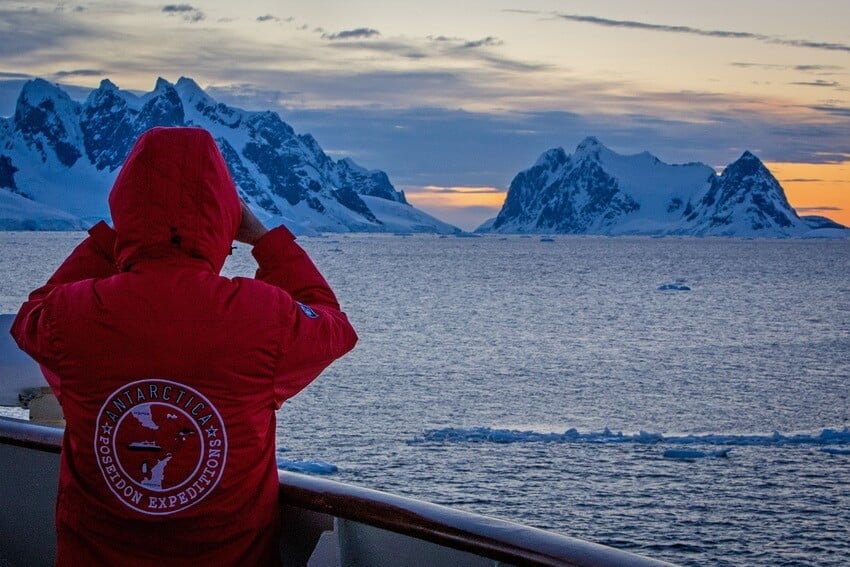Things to do in Antarctica
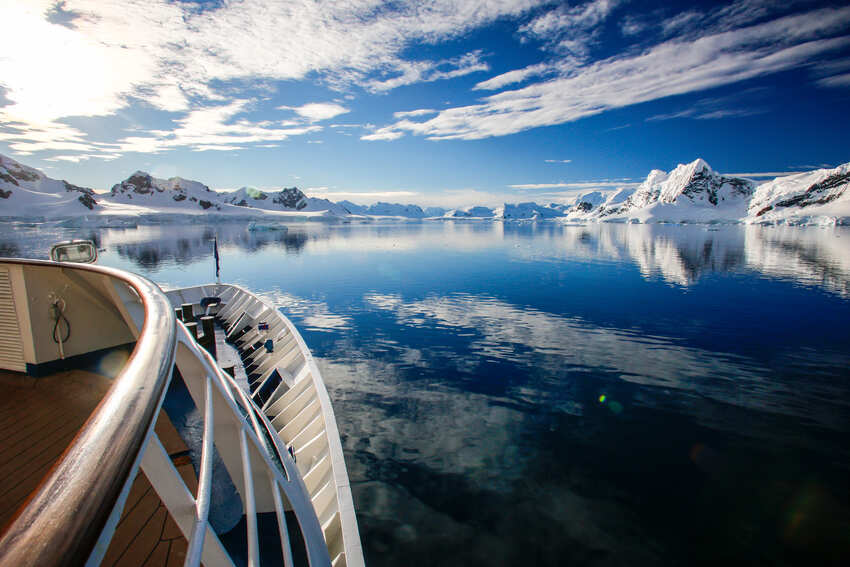
How do you imagine your perfect Antarctic adventure? Cruising aboard a small expedition ship, camping out in the wild, discovering incredible wildlife, cold-water diving, paddling the Southern Ocean or maybe even visiting a real research station? Whether you are a thrill-seeker, active explorer or relaxed traveler, there are many different things to do in Antarctica! A small-scale expedition cruise is the perfect way to venture out into the remote areas of Antarctica, and you get to choose the activities that will make the trip special and unforgettable. Get ready for a sneak peek and virtual mini excursion to the White Continent, and find out about our seven best things to do in Antarctica.

Kayaking in Antarctica
Nothing compares to launching a kayak into the most remote and beautiful bays on Earth! One of the best things to do in Antarctica is to explore at your own speed, in a small group, with professional instructors! Kayaking in Antarctica is the perfect adventure to enjoy the pristine nature, icebergs floating in the sea and wildlife going about its business in its natural habitat. Imagine exploring majestic glaciers, beautiful beaches with wildlife, abandoned whaling stations and even a historic shipwreck. Wildlife moves by you undisturbed, a whale may appear right next to your kayak or you may pass a leopard seal relaxing on an ice floe. You’ll get the prime opportunity to glide over crystal-clear waters and paddle amid mesmerizing iceberg formations. Look out for penguins jumping! Some kayakers are startled to see them darting out of the water onto the shore right next to them.
If you book an expedition cruise to Antarctica, ask immediately upon booking if kayaking is available. Places in the kayak club are usually limited and the earlier you secure your spot, the more likely you are to get in. And trust us, you really want to get one of these highly popular spots! You don’t have to be a professional to join a kayak group in Antarctica, but basic skills are essential. Our instructors will also give you training on how to use the equipment so you’re perfectly prepared for paddling in Antarctica. A dry suit will protect you from the cold waters, a spray skirt will ensure that you’ll stay dry inside the kayak, pogies (kayak mitts) keep your hands warm and you can even take your camera with you in a waterproof dry bag. Expedition cruises usually offer all the equipment included in the kayak club price, so you don’t have to bring anything yourself.
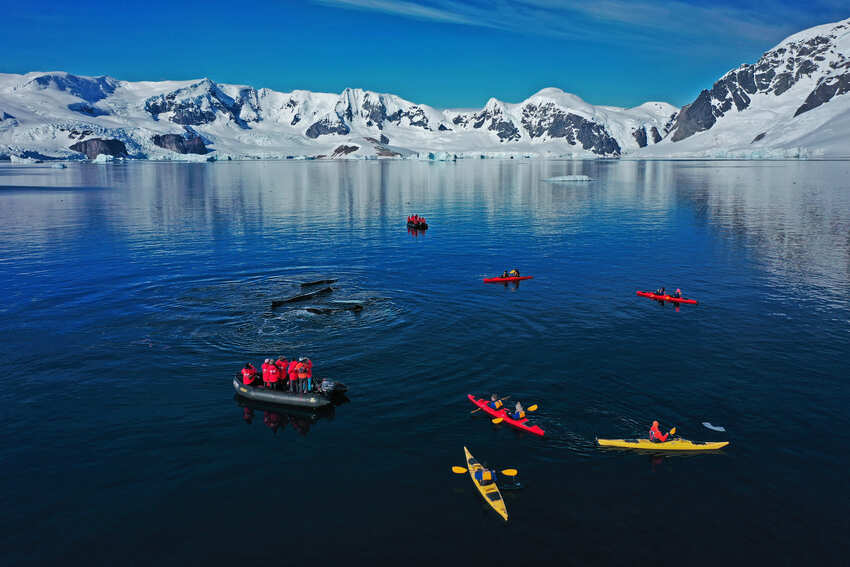
Whale Watching
The best way to see these gentle giants is on an Antarctic expedition cruise! Anyone who has visited Antarctica will tell you about the excitement you feel when you spot their fins on the horizon in between the waves. Whale watching requires some patience, but it’s worth it! Seeing a humpback whale jump out of the water is probably one of the things you’ll never forget in your lifetime. If you join an expedition cruise, onboard marine biologists and wildlife experts will help you recognize which whales you spotted and tell you everything you always wanted to know about these majestic creatures. Professional photographers will help you get the best shots of your whale encounters. Whales migrate throughout the year, and cover great distances. Some spend May and June in the Arctic and move south to catch the austral summer season. February to March is the prime season to spot whales in the Southern Ocean, as they return to feed in the Antarctic waters on nutritious kill.
You can spot various species around Antarctica and the subantarctic islands (such as South Georgia, King George Island and the South Shetland Islands):
- Humpback whales
- Minke whales
- Killer whales
- Sperm whales
- Southern right whales
- Baleen whales
- Fin whales
- Sei whales
- Blue whales
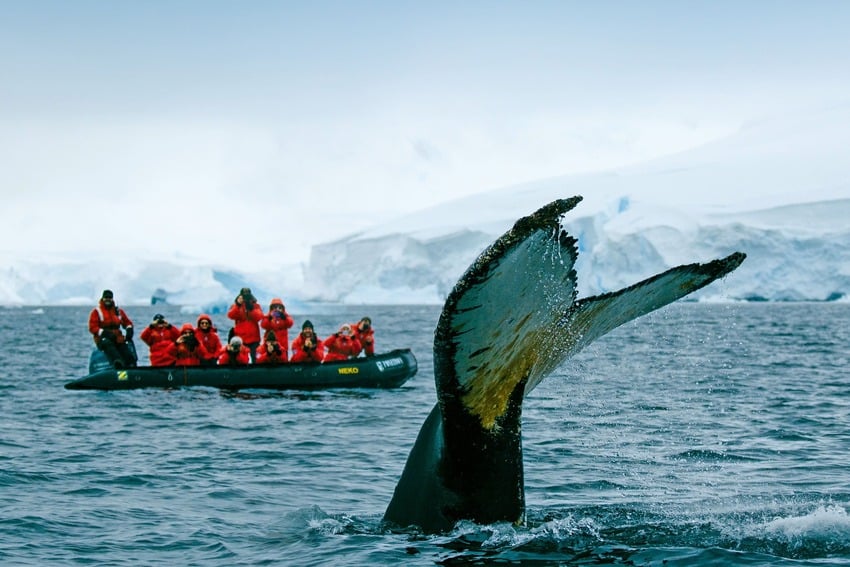
Whale watching is one of the more leisurely Antarctica attractions (as you can do it right from the deck of your expedition ship). You should start to look for them once you cross the Drake Passage en route to the Antarctic Peninsula. It’s a great way to distract yourself from motion sickness: enjoy the wide open deck, breathe in the fresh air and try to spot these aquatic giants. And don’t worry, if you’re relaxing in your cabin, your expedition team will keep you posted on wildlife sightings.
Another great way to encounter whales is during Zodiac cruises. Cruise in small, motorized boats, with only a handful of passengers aboard and get up close to marine and wildlife! It’s not unheard of to spot a whale swimming right next to your Zodiac boat.
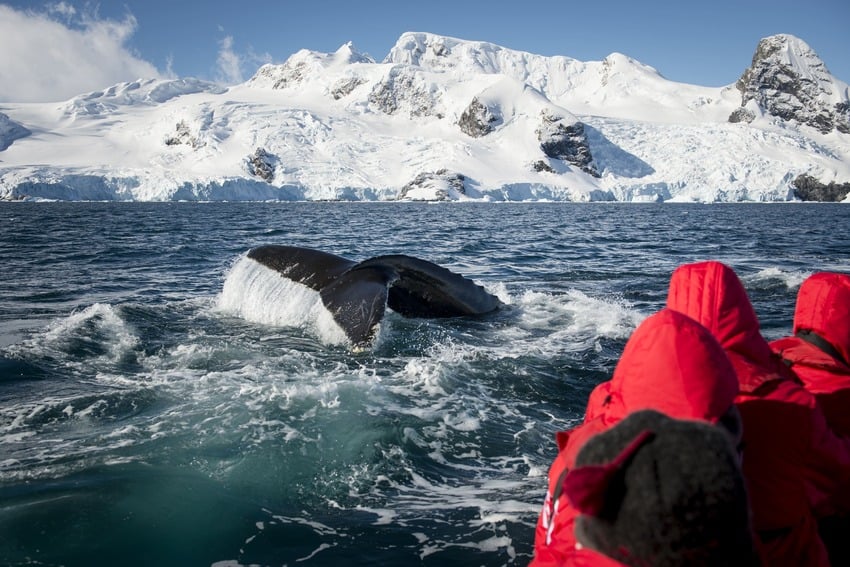
Camping in Antarctica
A pristine Antarctic shore, a beautiful bay, sea ice on the Southern Ocean, penguins cackling in the near distance… and you’re right in the middle of it in a cozy sleeping bag, under the sky of the Southern Hemisphere! That’s what camping on the Antarctic continent is like! If you visit Antarctica on a cruise expedition, make sure to check with your tour operator if camping in Antarctica is an option. Book ahead of time as spots are very limited and fill up quickly.
Tour operators will provide everything you’ll need to spend an unforgettable and comfortable night ashore: mummy sleeping bags, cotton sleeping bag liners, insulated sleeping pads and a bivy sack (a waterproof cover that goes over your sleeping bag). Worried about how you’ll go to the bathroom? Your expedition team will set up bio-toilet facilities to keep this pristine part of the world clean and carry out all waste after your camping experience. Only penguins and other Antarctic wildlife get to go freely when nature calls!
Even if you’re usually not a fan of camping, don’t miss your chance to enjoy a night out in the polar wilderness! Check out our top five reasons why camping is one of the best things to do in Antarctica:
-
Lifelong bragging rights: few people have slept in the open air on the White Continent!
-
Immerse yourself fully into polar nature: sleep among penguins, right on the pristine snow of the Antarctic Peninsula.
-
Get the best pictures: impress your friends with photos of your experience and show them your real explorer spirit!
-
Catch the best of the golden hours: Fall asleep and awake to the mesmerizing color spectrum of sunsets and sunrises in Antarctica.
-
Breakfast will never taste better again: no oats and instant coffee! You’ll return to your ship in the morning for a hearty breakfast with all the trimmings!
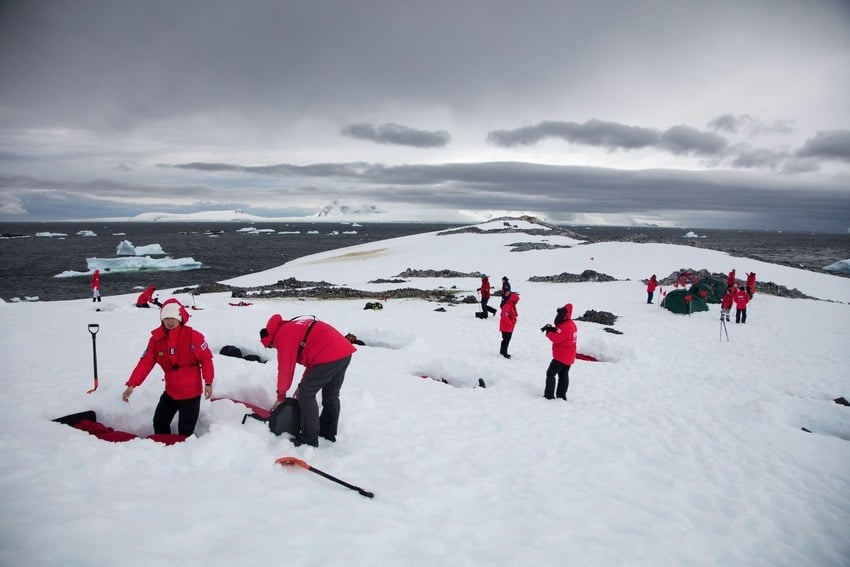
Spend Time with Penguins
For some travelers this may be the main reason to come all the way to Antarctica in the first place – penguin encounters! While you can see certain species such as the Galapagos penguin and the Magellanic penguin outside of Antarctica in South America, iconic Antarctic species are found nowhere else in the world in the wild.
Know your penguins and where to find them! Head to the Antarctic Peninsula, the subantarctic and the Falkland Islands to see chinstrap, adelie, gentoo and crested penguins such as Macaroni and the rockhopper. South Georgia Island has incredible king penguin colonies and it’s a unique experience to visit them! Nestled in one of the most beautiful and pristine places on Earth, you’ll see thousands of birds going about their business. There are more than 30 colonies on the island, but the largest is at St. Andrew Bay, which is a very popular stop on expedition cruises. A great way to spend time with penguins is to do it while hiking or camping ashore.
If you’re looking for the largest penguins in the world, head to Snow Hill Island in the Weddell Sea! This rarely visited emperor penguin colony consists of 4,000 breeding pairs, but is difficult to access. Visiting them means being airlifted by helicopter and unpredictable weather may delay or cancel your trip at any moment. While other penguin species breed during the Antarctic summer months, emperors breed in the harsh conditions of the austral winter (May-June).
A few pointers for your unforgettable penguin encounters:
-
Keep a distance! To protect wildlife, there is a 5-meter distance rule when you encounter penguins! This rule is not only to protect the penguins, but also for your safety! An encounter with a penguin beak is not a pleasant memory you want to take home.
-
Don’t chase, touch or feed them. It’s certainly tempting, but you can’t cuddle a penguin!
-
Why not sit down? Most penguins are curious fellows, and they may very well sneak up on you to check who’s visiting (and penguins do not adhere to the 5-meter rule).
-
Want to see penguin chicks? December is the best time to see the little ones hatching and in January you’ll see busy penguin parents attending to their chicks’ needs.
-
Be prepared for a foul odor near penguin colonies, as penguin guano is anything but pleasant smelling.
-
Get the perfect photo! But don’t forget to compensate for the high reflection of the snow when taking photographs (make sure to correct the aperture settings of your camera).
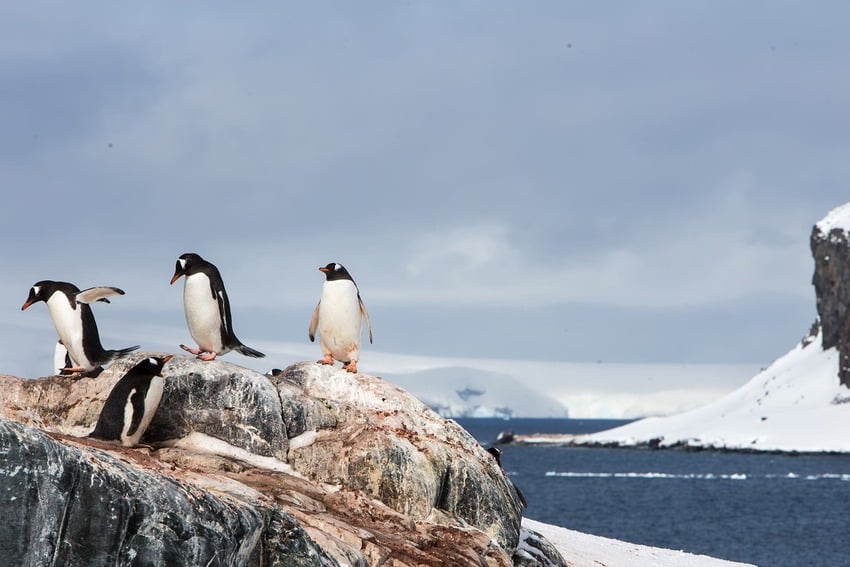
Scuba Diving
Looking for one of the most adventurous things to do in Antarctica? Join a diving expedition in the cold Antarctic waters! Scuba dive next to mesmerizing ice formations and enjoy incredible wildlife encounters below the water surface. Most people get to see Antarctic marine wildlife only on land or from deck of their cruise ship, Zodiac or kayak, but scuba diving will give you a completely new perspective. If 90% of an iceberg is below the water surface, why not explore it from all angles?
While seals may casually lounge and laze about on ice floes, they are amazing swimmers. Penguins may be slow and clumsy on land, but once you see them diving and swimming, you’ll be amazed how fast and nimble they actually are. As a scuba diver, you’ll get the rare experience to become part of the great sea life in Antarctica. Some of the popular diving spots are at McMurdo Sound in the Ross Sea (sea ice permitting),
This Antarctic activity is not for beginners. Most tour operators require at least 20-30 cold-water dives with a dry suit, documented dive logs, an internationally recognized diving qualification and medical clearance to participate.
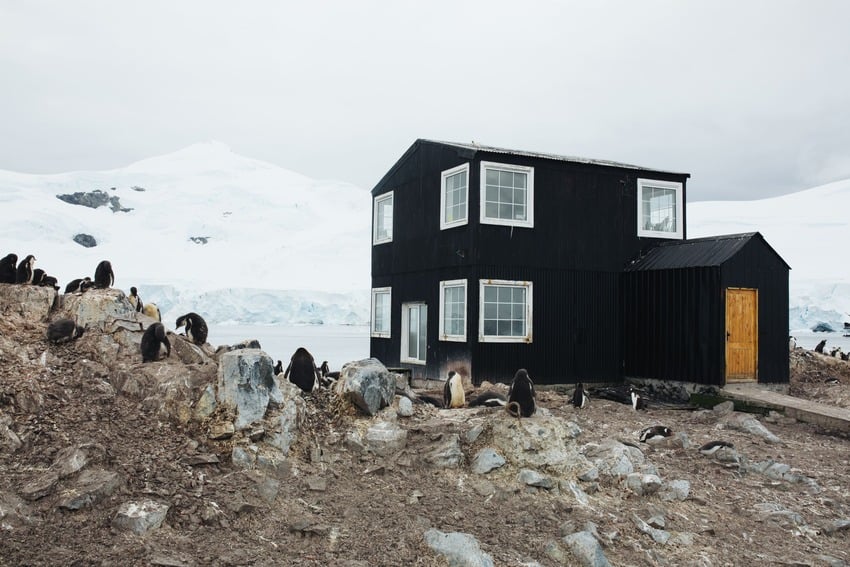
Visit a Research Station
Did you know that in Antarctica (one of the most remote places on Earth) cutting edge research regularly takes place? Since the signing of the Antarctic Treaty in December 1959, the continent is only to be used for peaceful research, scientific investigation and cooperation. But you don’t have to be a scientist to explore Antarctic research bases; some are even open to visitors! Visiting an active research station is one of the most interesting things to do in Antarctica, as you can see how scientific staff is living and working so far away from civilization.
Vernadsky research base (a former UK research station, acquired by the Ukraine in 1996) is actively encouraging visitors and many cruise companies stop by on their Antarctic Peninsula and Antarctic Circle cruises. This is the place where British scientists Joe Farman, Brian Gardiner and Jon Shanklin discovered the ozone hole over Antarctica in the 1980s. Another popular stop on many cruises is the Argentinian station Brown at the picturesque Paradise Harbor. Nowadays it’s only staffed in the Antarctic summer months, but many scientific publications on biology, glaciology, geophysics and ozone monitoring originated here.
Dive into the unique atmosphere of station life, chat with the staff and appreciate the amazing surroundings. While it’s extremely remote with cold weather year-round, it’s one of the most unique and exciting spots to be based, with regular penguin encounters! You may even get a little envious of the local scientists when you think of your office life back home.
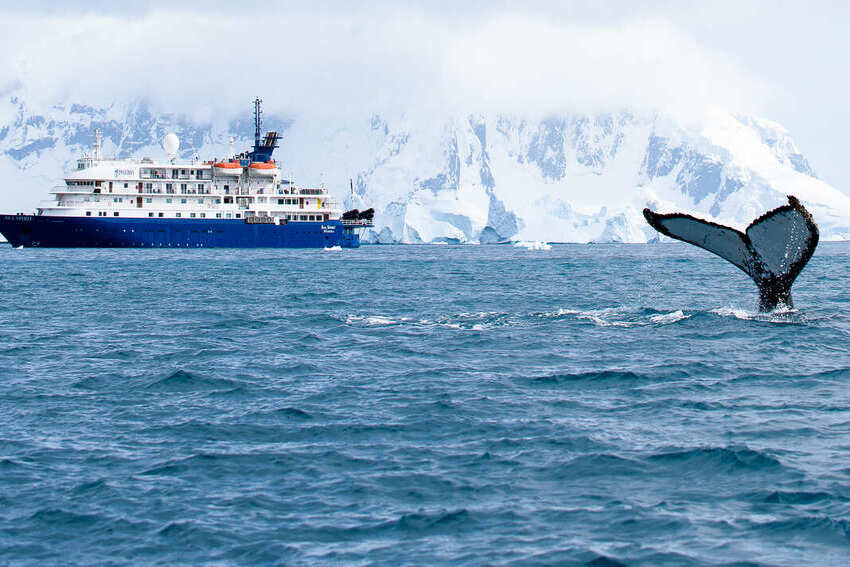
Do the Polar Plunge
It’s the crowning moment of your epic adventure and Antarctica cruise! You may have gotten your sea legs on your epic voyage, but do you have what it takes to dive into one of the coldest oceans in the world? After all, you won’t get to wear a dry suit for this adventure! Get ready to jump and get ultimate bragging rights from this experience! The polar plunge is one of the most daring things to do in Antarctica and travelers often prepare in advance. What to wear? How to jump? With or without a waterproof GoPro camera? Make this memory count! After all, our professional photographers will capture this moment on camera for a unique memory to take home with you.
You’ll jump right off the expedition ship into the icy water, surrounded by the most breathtaking scenery in the world. And don’t worry, our professional team is standing by, should you need any assistance.
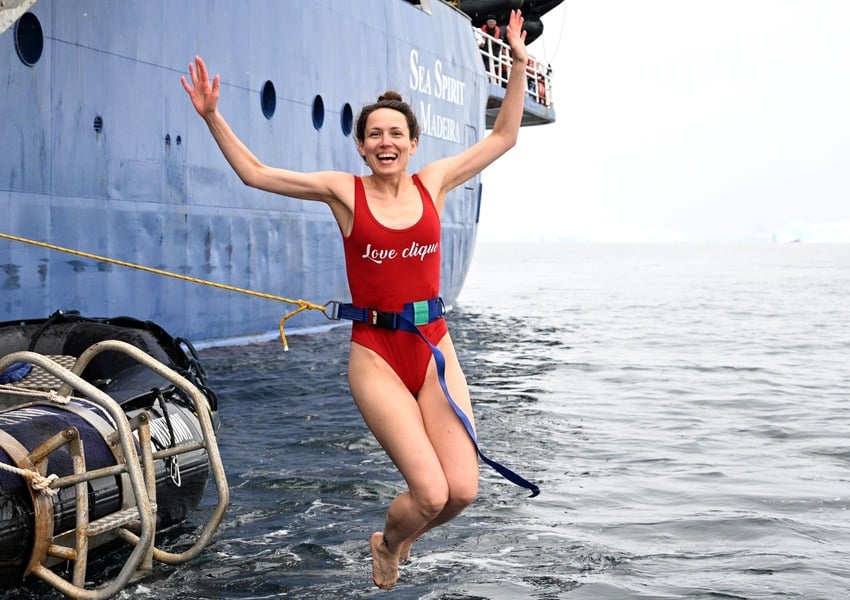
FAQs
Does Antarctica have tourist attractions?
Antarctica attractions may not be what you expect if you compare them to what is offered at your typical tourist destination. But for real explorers, the White Continent has many interesting things to see. Among the top Antarctica attractions after wildlife watching and exploring pristine landscapes are the visits to abandoned whaling stations on the subantarctic islands (with southern elephant seals roaming the abandoned remains), the penguin post office at Port Lockroy (you can send yourself and loved-ones a postcard from this remote post office) and various science research stations that welcome visitors
What activities do people do in Antarctica?
It all depends on your adventurous spirit! Some travelers prefer to see the picturesque coasts and unique marine life from aboard a cruise ship. Your Antarctic cruise may also offer active excursions in sea kayaks, camping ashore the White Continent, visiting research stations and even excursions ashore such as exploring an active volcano on Deception Island. Adventurous polar travelers can also fly to camps in interior Antarctica for ski touring and ice climbing. Some tour operators even offer polar scuba diving in Antarctic waters. Whatever you choose, a trip to Antarctica is always an amazing experience.
How cold is it in Antarctica?
While average winter temperatures range from -60C (-76F) around the South Pole and -15/20C (-5/4F) at the coasts, summers can be quite pleasant. Austral summer temperatures at the South Pole are usually around -28C (-18F) and 0C (32F) on the Antarctic Peninsula. Expedition cruises visit Antarctica during the summer months, when the weather is pleasant and warm enough to kayak, camp, hike and explore in Zodiacs.
Which wildlife is found in Antarctica?
This region is a dream location for wildlife watching! On the Antarctic continent, you’ll find various penguin species such as gentoo penguins, emperor penguins and adelie penguins. You can see king penguins on South Georgia Island. Other wildlife includes sea lions and seals (e.g. elephant seals, fur seals and leopard seals). Birders can expect seabird encounters (such as albatrosses, petrels, kelp gulls and skuas) and, depending on the season (the best time is February and March), you may also spot various types of whales that come to feed in the krill-rich Southern Ocean.
